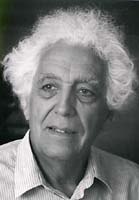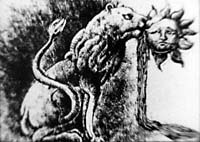Nag Ansorge discusses his teaching experiences at The Psychiatric Clinic of the University of Lausanne and describes the patients' animation production process as well as the films that they created. In English and French.

Nag Ansorge
In 1962, I had just finished filming a documentary about the new buildings of the Cery Psychiatric Hospital near Lausanne, Switzerland when I Professor Muller suggested the idea of acquiring a 16 mm camera for his patients. "What could you do with a camera and some patients?" he asked me. A little infatuated with the idea, I said, "I'm going to try to do something... The experiment interests me. How will I introduce myself to a group of patients that I don't know at all?" However, I have to say that after the first 30 seconds, my infatuation was satisfied. I asked the first group of patients, "Do you have anything to say or show by means of a camera?" There was hardly a moment of silence. They all suddenly said, "Yes, there's something to say." My experiment lasted 19 years. Thirteen films were made, from 10 to 20 minutes in length, of which eight were animated.
Creating a Team
In the beginning, one thought they would have filmed flowers, family scenes, memories, but they didn't go in that direction at all. Rather they wanted to produce an expressive film in live-action. Above all, they wanted to create in animation. An animation stand was built by a patient who had been a carpenter. The preferred animation technique was paper cut-outs. The technique allowed them to share the work as a group. The close collaboration among the participants gave each one a feeling of responsibility about the finished work. Each was driven to establish tight rapport with the others. It wasn't possible to do something alone or isolated within the framework of the group, nor could anyone keep aloof. From the very first film it was proven that filmmaking was an excellent therapeutic means to encourage patients who had difficulty relating to others to come out of their shells and collaborate. The group:
- discussed the script
- chose a script that could be made by the group
- made character drawings, details and backgrounds cut out the drawings
- shot the animation beneath the camera frame by frame
- lit the set to be shot with the camera frame by frame
- lit the set to be shot with the camera frame by frame
- dited the film and prepared the soundtrack
- eventually wrote a text and recorded it
Producing Independently
In order for the films to yield authentic results, it is necessary for the group to work in a perfectly independent fashion. They shouldn't feel that they are being observed, that is to say, that they are being the subjects of an experiment or a test for the doctors. In fact, we established from the beginning that any time a doctor or a nurse was present at one of the sessions, the patients showed a stagnation and an absence of spontaneity in their work. As a result, Professor Muller decided to let the group work in a completely autonomous manner. Consequently anything could be said among the filmmaking group without the doctors or caretakers being informed.

The four images are from the group's first film, The Poet And The Unicorn (1963). Images courtesy of Nag Film.
Obviously, my presence also risked being resented as a disturbing foreign body, but the fact that I belonged neither to the medical nor the caretaking staff made things easier for me. The patients had to feel at ease around me. I had to be present and available at the same time that I was invisible. I could give all the technical advice they wanted, but I was strictly forbidden to get involved with or offer criticism about the form or content of the film. The members of the group filmed and critiqued the results themselves. If they weren't satisfied, they started working all over again. This was the only way that these films could give an authentic reflection of the experiences that the patients had lived through. It was also a means of maintaining enthusiasm over the long time period required to complete a film. The production of an animation film required about a year, with a group of seven or eight patients working one morning a week. Of course the duration of participation by various patients varied, and new patients would soon take up where someone else had left off. The participation of the patients was completely voluntary. They came to work because they liked it, I think, and if they left, it was because something bothered them. Maybe it was a certain opposition, be it to the group or to the mode of working, or to the script... That's normal and that's how it goes!
The First Film
Using a few live-action shots, The Poet And The Unicorn (1963) was the first animation film done. It is the story of a poet who wants to be free of his dreams. The script was written by one of the members of the group, who also played a character. The other members of the group made sketches to develop the main character. Hundreds of pages from illustrated magazines were selected and cut out in order to make the collages for the backgrounds. The patients used this collage technique because of its simplicity and the good results that it gave in projection. The members of the group realized very quickly that every person is able to make a valuable contribution, without necessarily possessing any particular artistic gifts. Therefore, everyone drew, painted, cut out or glued. Then they would move the figures in minute increments beneath the animation camera, filming one frame after another, revealing a certain patience for the work. If the weather permitted, the group could also shoot footage outdoors. Sometimes members of the hospital personnel might play bit parts. A horse was loaned to one production by a neighboring farmer, and once a group of messenger pigeons were released for a particular shot. Everyone watched the rushes and carefully judged the quality of each scene, and some would be done over again if necessary. The critical discussion reinforced the feelings of interdependence and homogeneity of the group. Everyone could participate in the discussion and speak his personal opinion, but in the end all accepted the majority decision.
The soundtrack, recorded by the group, was mixed in my studio, quite according to their instructions. This film, finished in 1963, was shown in hospitals to doctors and students, and in 1965 it received the "Minerva" award at the International Medical-Scientific Film Festival. This success was a happy encouragement to everyone. The film ran 17 minutes.
Further Work Good Day My Eye was a film made up of sketches that were each told by a different patient. Most of the members of the first group had left the hospital, so it took some time for the new arrivals to agree on a theme for the script. Finally they decided to present the daily life of a fictional patient, hospitalized and cut off from the outside world. The preoccupations of each person, including their issues with the hospital and its staff, would find a place to be expressed here: the importance of food, relationships with visitors, experiences of isolation, delirious interpretations of the surroundings, feelings of ambivalence for the care giving personnel, etc. On a technical level, animation was mixed with live-action. The film runs 16 minutes. The Seven Nights Of Siberia (1967) is also a film made up of sketches. While searching for an idea for the next film's script, the group started telling jokes they knew about "crazy people", just to pass the time. Suddenly a patient told a very funny story about a "nut case". Everyone laughed, but the man who told the joke cried, "You're laughing, but the person you're laughing about is me!" The others said, "O.K., we've found the idea. We're going to tell all the jokes like this about crazies, so the public will realize that behind each of these jokes is something true, something that really happened, and that we are the people that they're about!" This 13 minute film is not at all funny, it's very moving, because the emphasis isn't on the gag but on the real content. Ten other films were made in this manner up until 1981. This experience might be compared to a rather similar work done at the same time by Rene Laloux (France) for a film titled The Teeth Of The Monkey (1960), but there, the drawings of mental patients were animated by professional animators without any participation by the patients. In 1997 Robert Studio in Brussels produced the film A Christmas Like Any Other, written, performed, animated and synchronized with music by mentally handicapped artists.

Alchemia, the last film that Nag and Gisèle Ansorge made together. © Nag Film.
A Life Altering Experience
On a personal level, this activity was a revelation for me. Since I didn't represent any medical authority, my relationship with the patients gradually became very direct and friendly. The way in which the patients analyzed things and made judgments allowed me to learn to know myself better. I discovered a world profoundly human, which had to work with very great suffering, the intensity of which is hard to imagine.
These films should not arouse compassion, but rather an interest and a sense of active conscience in the face of the mystery of mental illness. The discovery of this thrilling milieu has certainly greatly influenced the themes treated in the films Gisèle, my wife, and I made.
Translated from French by William Moritz.
Nag Ansorge is a prestigous, ground breaking live-action and animation filmmaker from Switzerland.
A showcase of Nag and Gisèle Ansorge's work is featured in the AWN Gallery. Please read the The Animation Flash Email Newsletter for a premiere date.







